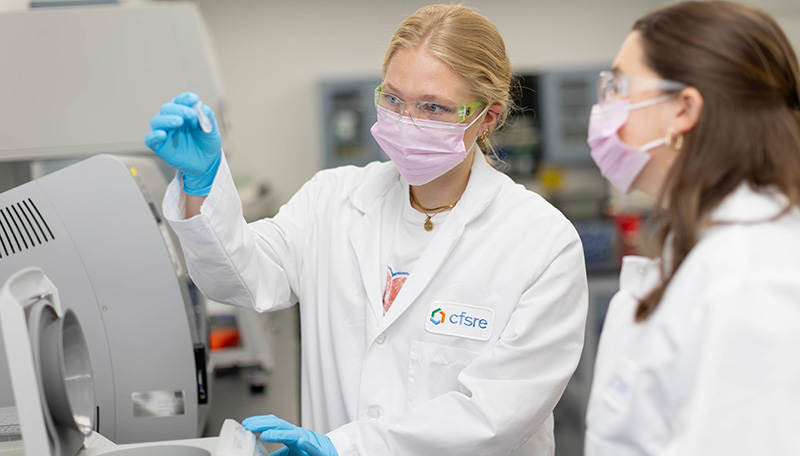DNA testing can link an item of evidence to an individual, but it cannot identify the biological fluid from which the genetic material originated. Such basic information, however, is often critical to identifying probative evidence in a criminal investigation. In contrast to the technological advancements in DNA testing, serological identification still relies on classical chemical, enzyme activity, and antibody-based assays. These methods are unable to detect body fluids as vaginal secretions and menstrual blood – both of which are commonly encountered in sexual assault cases. Moreover, for bodily fluids that can be detected, existing technologies yield only a presumptive indication of a target body fluid while often consuming unacceptable quantities of precious evidence.

Researchers at the CFSRE have developed protein mass spectrometry-based techniques for the confirmatory identification of several forensically relevant biological fluids. Over the last decade, these improved serological workflows have been validated for forensic use. The current focus of this work at the CFSRE is to increase throughput through the use of automation and novel mass spectrometry strategies, including top-down/intact analysis, protein and peptide immuno-purification, and protease-free workflows.
Benefits
- Protein mass spectrometry provides true confirmatory results for six forensically relevant body fluids, including peripheral and menstrual blood, vaginal fluid, urine, saliva, and seminal fluid.
- The workflow allows for the simultaneous detection of all six fluids, even in mixed samples.
- Automation and liquid handling systems have enabled high throughput sample processing.
Resources
The CFSRE continues to present this work at national and international conferences as well as in peer-reviewed publications.
Peer-reviewed publications
- High-throughput seminal fluid identification by automated immunoaffinity mass spectrometry. Journal of forensic sciences vol. 67,3 (2022): 1184-1190. doi:10.1111/1556-4029.14975
- Alternative LC-MS/MS Platforms and Data Acquisition Strategies for Proteomic Genotyping of Human Hair Shafts. Journal of proteome research vol. 20,10 (2021): 4655-4666. doi:10.1021/acs.jproteome.1c00209
- Developmental validation of a multiplex proteomic assay for the identification of forensically relevant biological fluids. Forensic science international, vol. 326 110908. 17 Jul. 2021, doi:10.1016/j.forsciint.2021.110908
- Forensic proteomics. Forensic science international. Genetics vol. 54 (2021): 102529. doi:10.1016/j.fsigen.2021.102529
- Direct seminal fluid identification by protease-free high-resolution mass spectrometry. Journal of forensic sciences vol. 66,3 (2021): 1017-1023. doi:10.1111/1556-4029.14646
- Verification of protein biomarker specificity for the identification of biological stains by quadrupole time-of-flight mass spectrometry. Electrophoresis vol. 38,6 (2017): 833-845. doi:10.1002/elps.201600352
- Discovery of highly specific protein markers for the identification of biological stains. Electrophoresis vol. 35,21-22 (2014): 3069-78. doi:10.1002/elps.201400125
PRESENTATIONS
- Assessment of Robotic Solid Phase and Immunoaffinity Microextraction with Intact Mass Analysis for Saliva Identification in Forensic Samples. 2022. American Academy of Forensic Sciences Annual Scientific Meeting
- Development of an Automated Immunoaffinity Mass Spectrometry Assay for Seminal Fluid Identification in Sexual Assault Samples. 2021 ASMS Conference on Mass Spectrometry and Allied Topics
- Assessment of a Protease-Free Method for Body Fluid Identification in Sexual Assault Evidence by Directed MS/dd-MS2 HRMS. 2021 ASMS Conference on Mass Spectrometry and Allied Topics
- Assessing Potential Inhibitory Effects of Personal Lubricant on the Ability to Detect Biomarkers Consistent with Semen, Saliva, and Vaginal Fluid”, 2019 71st annual scientific meeting, Seattle, WA.
 Researchers at the CFSRE have developed protein mass spectrometry-based techniques for the confirmatory identification of several forensically relevant biological fluids. Over the last decade, these improved serological workflows have been validated for forensic use. The current focus of this work at the CFSRE is to increase throughput through the use of automation and novel mass spectrometry strategies, including top-down/intact analysis, protein and peptide immuno-purification, and protease-free workflows.
Researchers at the CFSRE have developed protein mass spectrometry-based techniques for the confirmatory identification of several forensically relevant biological fluids. Over the last decade, these improved serological workflows have been validated for forensic use. The current focus of this work at the CFSRE is to increase throughput through the use of automation and novel mass spectrometry strategies, including top-down/intact analysis, protein and peptide immuno-purification, and protease-free workflows. 







